BDS Dual-Frequency Carrier Phase Multipath Hemispherical Map Model and Its Application in Real-Time Deformation Monitoring
Abstract
1. Introduction
2. Dual-Frequency DD Residuals and Reconstruction of SD Residuals
3. MHM Model for BDS Dual-Frequency Carrier Phase Multipath Mitigation
3.1. Multipath Basic Principle
3.2. Spatial Repetition Characteristics Analysis of BDS Carrier Phase Observation Residuals
3.3. Methodology of BDS Dual-Frequency MHM
3.3.1. Hemispherical Geometric Model
3.3.2. Hemispherical Grid Parameter Fitting
4. Experiment Analysis
4.1. CUMT Building Roof Experiment Case
4.2. River Culvert Deformation Monitoring Experiment Case
5. Conclusions
Author Contributions
Funding
Institutional Review Board Statement
Informed Consent Statement
Data Availability Statement
Conflicts of Interest
References
- Teunissen, P.; Montenbruck, O. Springer Handbook of Global Navigation Satellite Systems—Chinese Navigation Satellite Systems; Springer: Berlin/Heidelberg, Germany, 2017. [Google Scholar]
- Yang, Y.; Ding, Q.; Gao, W.; Li, J.; Xu, Y.; Sun, B. Principle and Performance of BDSBAS and PPP-B2b of BDS-3. Satell. Navig. 2022, 3, 5. [Google Scholar] [CrossRef]
- Braasch, M.S. Multipath Effects. Parkinson 1996, 11, 505–514. [Google Scholar]
- Xu, W.; Yan, C.; Chen, J. Performance Evaluation of BDS-2/BDS-3 Combined Precise Time Transfer with B1I/B2I/B3I/B1C/B2a Five-Frequency Observations. GPS Solut. 2022, 26, 80. [Google Scholar] [CrossRef]
- Liu, X.; Zhang, S.; Zhang, Q.; Zheng, N.; Zhang, W.; Ding, N. Theoretical Analysis of the Multi-GNSS Contribution to Partial Ambiguity Estimation and R-Ratio Test-Based Ambiguity Validation. GPS Solut. 2021, 25, 52. [Google Scholar] [CrossRef]
- Xu, G. GPS Theory, Algorithms and Applications, 1st ed.; Tsinghua University Press: Beijing, China, 2003. [Google Scholar]
- Hofmann-Wellenhof, B.; Lichtenegger, H.; Wasle, E. GNSS–Global Navigation Satellite Systems: GPS, GLONASS, Galileo, and More; Springer: Berlin/Heidelberg, Germany, 2007. [Google Scholar]
- Suya, R.G.; Chen, Y.-T.; Kwong, C.F.; Zhang, P. BeiDou Intra-System Bias Using Different Precise Orbit and Clock Products. Measurement 2022, 191, 110804. [Google Scholar] [CrossRef]
- Liu, C.; Tao, Y.; Xin, H.; Zhao, X.; Liu, C.; Hu, H.; Zhou, T. A Single-Difference Multipath Hemispherical Map for Multipath Mitigation in BDS-2/BDS-3 Short Baseline Positioning. Remote Sens. 2021, 13, 304. [Google Scholar] [CrossRef]
- Maqsood, M.; Gao, S.; Brown, T.; Unwin, M. Effects of Ground Plane on the Performance of Multipath Mitigating Antennas for GNSS. In Proceedings of the 2010 Loughborough Antennas & Propagation Conference, Loughborough, UK, 8–9 November 2010; pp. 241–244. [Google Scholar]
- Filippov, V.; Tatarnicov, D.; Ashjaee, J.; Astakhov, A.; Sutiagin, I. The First Dual-Depth Dual-Frequency Choke Ring. In Proceedings of the 11th International Technical Meeting of the Satellite Division of The Institute of Navigation (ION GPS 1998), Nashville, TN, USA, 15–18 September 1998; pp. 1035–1040. [Google Scholar]
- Krantz, E.; Riley, S.; Large, P. The Design and Performance of the Zephyr Geodetic Antenna. In Proceedings of the 14th International Technical Meeting of the Satellite Division of the Institute of Navigation (ION GPS 2001), Salt Lake City, UT, USA, 11–14 September 2001; pp. 1942–1951. [Google Scholar]
- Groves, P.D.; Jiang, Z.; Skelton, B.; Cross, P.A.; Lau, L.; Adane, Y.; Kale, I. Novel Multipath Mitigation Methods Using a Dual-Polarization Antenna. In Proceedings of the 23rd International Technical Meeting of the Satellite Division of the Institute of Navigation (ion Gnss 2010), Portland, OR, USA, 21–24 September 2010; pp. 140–151. [Google Scholar]
- van Nee, R.D.J. The Multipath Estimating Delay Lock Loop. In Proceedings of the IEEE Second International Symposium on Spread Spectrum Techniques and Applications, Yokohama, Japan, 29 November–2 December 1992; pp. 39–42. [Google Scholar]
- Chen, X.; Dovis, F.; Peng, S.; Morton, Y. Comparative Studies of GPS Multipath Mitigation Methods Performance. IEEE Trans. Aerosp. Electron. Syst. 2013, 49, 1555–1568. [Google Scholar] [CrossRef]
- Qiu, W.; Zeng, Q.; Xu, R.; Liu, J.; Shi, J.; Meng, Q. A Multipath Mitigation Algorithm for GNSS Signals Based on the Steepest Descent Approach. Satell. Navig. 2022, 3, 14. [Google Scholar] [CrossRef]
- Danskin, S.; Bettinger, P.; Jordan, T. Multipath Mitigation under Forest Canopies: A Choke Ring Antenna Solution. For. Sci. 2009, 55, 109–116. [Google Scholar]
- Maqsood, M.; Gao, S.; Brown, T.W.C.; Unwin, M.; de vos Van Steenwijk, R.; Xu, J.D. A Compact Multipath Mitigating Ground Plane for Multiband GNSS Antennas. IEEE Trans. Antennas Propag. 2013, 61, 2775–2782. [Google Scholar] [CrossRef]
- Zhang, Z.; Li, B.; Shen, Y.; Gao, Y.; Wang, M. Site-Specific Unmodeled Error Mitigation for GNSS Positioning in Urban Environments Using a Real-Time Adaptive Weighting Model. Remote Sens. 2018, 10, 1157. [Google Scholar] [CrossRef]
- Axelrad, P.; Larson, K.; Jones, B. Use of the Correct Satellite Repeat Period to Characterize and Reduce Site-Specific Multipath Errors. In Proceedings of the 18th International Technical Meeting of the Satellite Division of the Institute of Navigation (ION GNSS 2005), Long Beach, CA, USA, 13–16 September 2005. [Google Scholar]
- Zhong, P.; Ding, X.L.; Zheng, D.W.; Chen, W.; Huang, D.F. Adaptive Wavelet Transform Based on Cross-Validation Method and Its Application to GPS Multipath Mitigation. GPS Solut. 2008, 12, 109–117. [Google Scholar] [CrossRef]
- Zhong, P.; Ding, X.; Yuan, L.; Xu, Y.; Kwok, K.; Chen, Y. Sidereal Filtering Based on Single Differences for Mitigating GPS Multipath Effects on Short Baselines. J. Geod. 2010, 84, 145–158. [Google Scholar] [CrossRef]
- Dai, W.; Shi, Q.; Cai, C. Characteristics of the BDS Carrier Phase Multipath and Its Mitigation Methods in Relative Positioning. Sensors 2017, 17, 796. [Google Scholar] [CrossRef]
- Ansari, K.; Bae, T.S. Wavelet and Power Spectrum Analysis of Global Navigation Satellite System Multipath Error Modelling and Mitigation. Int. J. Satell. Commun. Netw. 2021, 39, 626–644. [Google Scholar] [CrossRef]
- Ye, S.; Chen, D.; Liu, Y.; Jiang, P.; Tang, W.; Xia, P. Carrier Phase Multipath Mitigation for BeiDou Navigation Satellite System. Gps Solut. 2015, 19, 545–557. [Google Scholar] [CrossRef]
- Zhang, Q.; Yang, W.; Zhang, S.; Liu, X. Characteristics of BeiDou Navigation Satellite System Multipath and Its Mitigation Method Based on Kalman Filter and Rauch-Tung-Striebel Smoother. Sensors 2018, 18, 198. [Google Scholar] [CrossRef] [PubMed]
- Fuhrmann, T.; Luo, X.; Knöpfler, A.; Mayer, M. Generating Statistically Robust Multipath Stacking Maps Using Congruent Cells. GPS Solut. 2015, 19, 83–92. [Google Scholar] [CrossRef]
- Wang, Z.; Chen, W.; Dong, D.; Wang, M.; Cai, M.; Yu, C.; Zheng, Z.; Liu, M. Multipath Mitigation Based on Trend Surface Analysis Applied to Dual-Antenna Receiver with Common Clock. GPS Solut. 2019, 23, 104. [Google Scholar] [CrossRef]
- Dong, D.; Wang, M.; Chen, W.; Zeng, Z.; Song, L.; Zhang, Q.; Cai, M.; Cheng, Y.; Lv, J. Mitigation of Multipath Effect in GNSS Short Baseline Positioning by the Multipath Hemispherical Map. J. Geod. 2016, 90, 255–262. [Google Scholar] [CrossRef]
- Lu, R.; Chen, W.; Dong, D.; Wang, Z.; Zhang, C.; Peng, Y.; Yu, C. Multipath Mitigation in GNSS Precise Point Positioning Based on Trend-Surface Analysis and Multipath Hemispherical Map. GPS Solut. 2021, 25, 119. [Google Scholar] [CrossRef]
- Zheng, K.; Zhang, X.; Li, P.; Li, X.; Ge, M.; Guo, F.; Sang, J.; Schuh, H. Multipath Extraction and Mitigation for High-Rate Multi-GNSS Precise Point Positioning. J. Geod. 2019, 93, 2037–2051. [Google Scholar] [CrossRef]
- Ma, D.; Zhao, K.; Zheng, Z.; Yu, C.; Wang, Y.; Yao, Y. Indoor Positioning With Adaptive Wavelet Denoise Enhancement and Trend Surface Analysis Based Multipath Map. IEEE Sens. J. 2022, 22, 15191–15198. [Google Scholar] [CrossRef]
- Tao, Y.; Liu, C.; Liu, C.; Zhao, X.; Hu, H.; Xin, H. Joint Time-Frequency Mask and Convolutional Neural Network for Real-Time Separation of Multipath in GNSS Deformation Monitoring. GPS Solut. 2021, 25, 25. [Google Scholar] [CrossRef]
- Zou, X.; Li, Z.; Wang, Y.; Deng, C.; Li, Y.; Tang, W.; Fu, R.; Cui, J.; Liu, J. Multipath Error Fusion Modeling Methods for Multi-GNSS. Remote Sens. 2021, 13, 2925. [Google Scholar] [CrossRef]
- Hu, M.; Yao, Y.; Ge, M.; Neitzel, F.; Shi, J.; Pan, P.; Yang, M. Random Walk Multipath Method for Galileo Real-Time Phase Multipath Mitigation. GPS Solut. 2023, 27, 58. [Google Scholar] [CrossRef]
- Tian, Y.; Liu, Z.; Lin, M.; Li, K. Modelling and Mitigation of GNSS Multipath Effects by Least-Squares Collocation Considering Spatial Autocorrelation. J. Geod. 2023, 97, 37. [Google Scholar] [CrossRef]
- Alber, C.; Ware, R.; Rocken, C.; Braun, J. Obtaining Single Path Phase Delays from GPS Double Differences. Geophys. Res. Lett. 2000, 27, 2661–2664. [Google Scholar] [CrossRef]
- Chen, D.; Ye, S.; Xia, F.; Cheng, X.; Zhang, H.; Jiang, W. A Multipath Mitigation Method in Long-Range RTK for Deformation Monitoring. GPS Solut. 2022, 26, 96. [Google Scholar] [CrossRef]


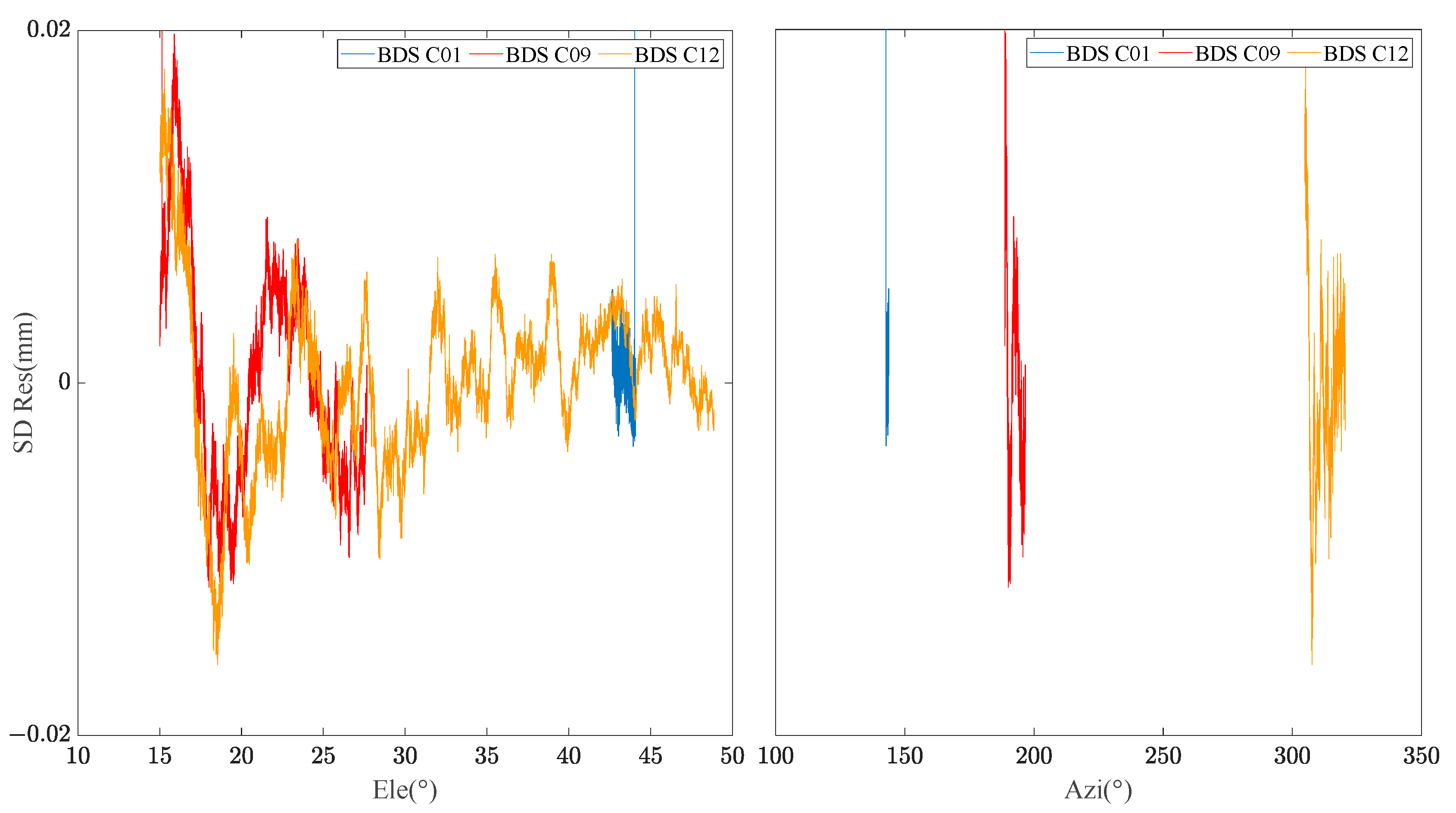
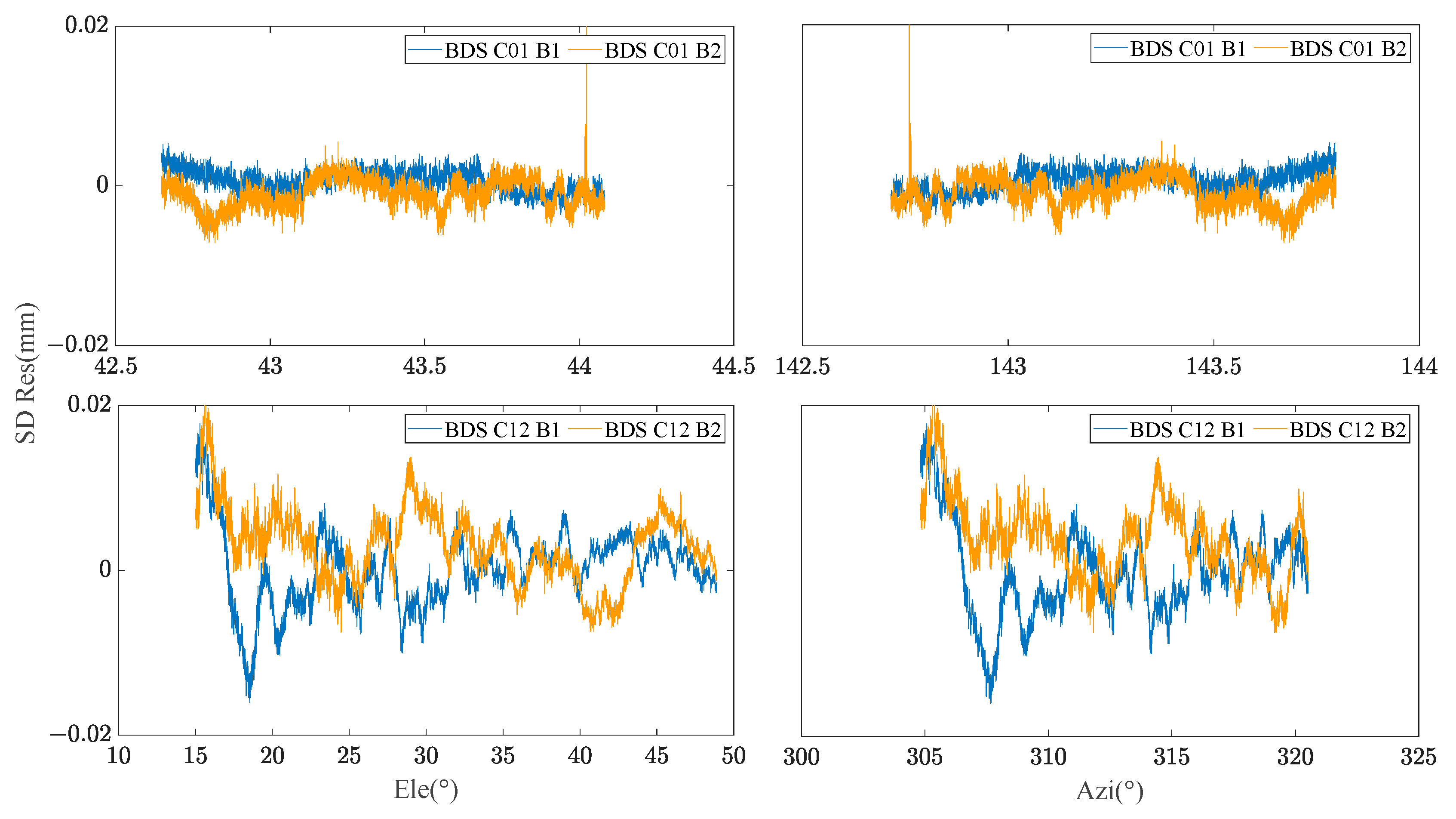
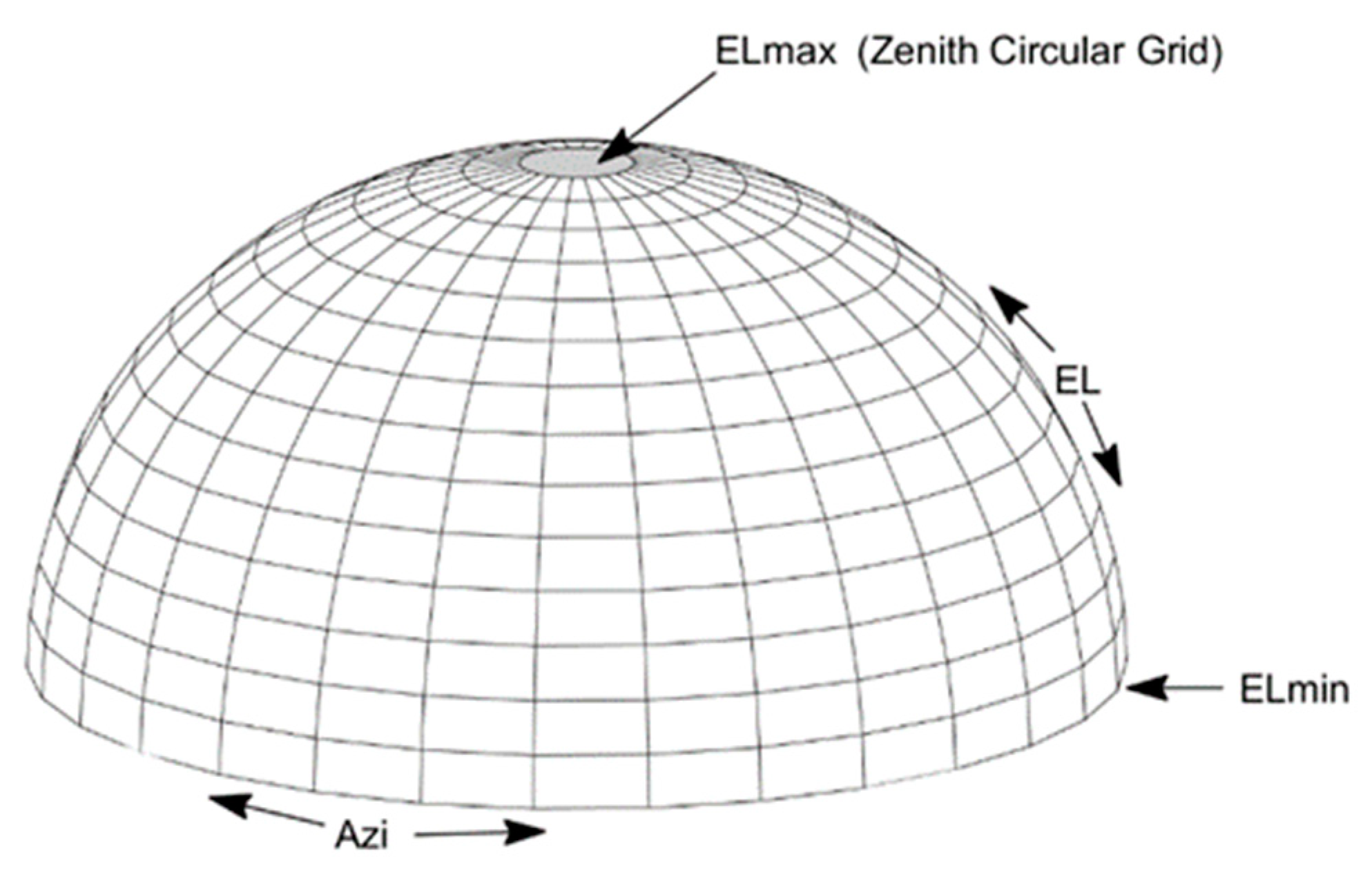

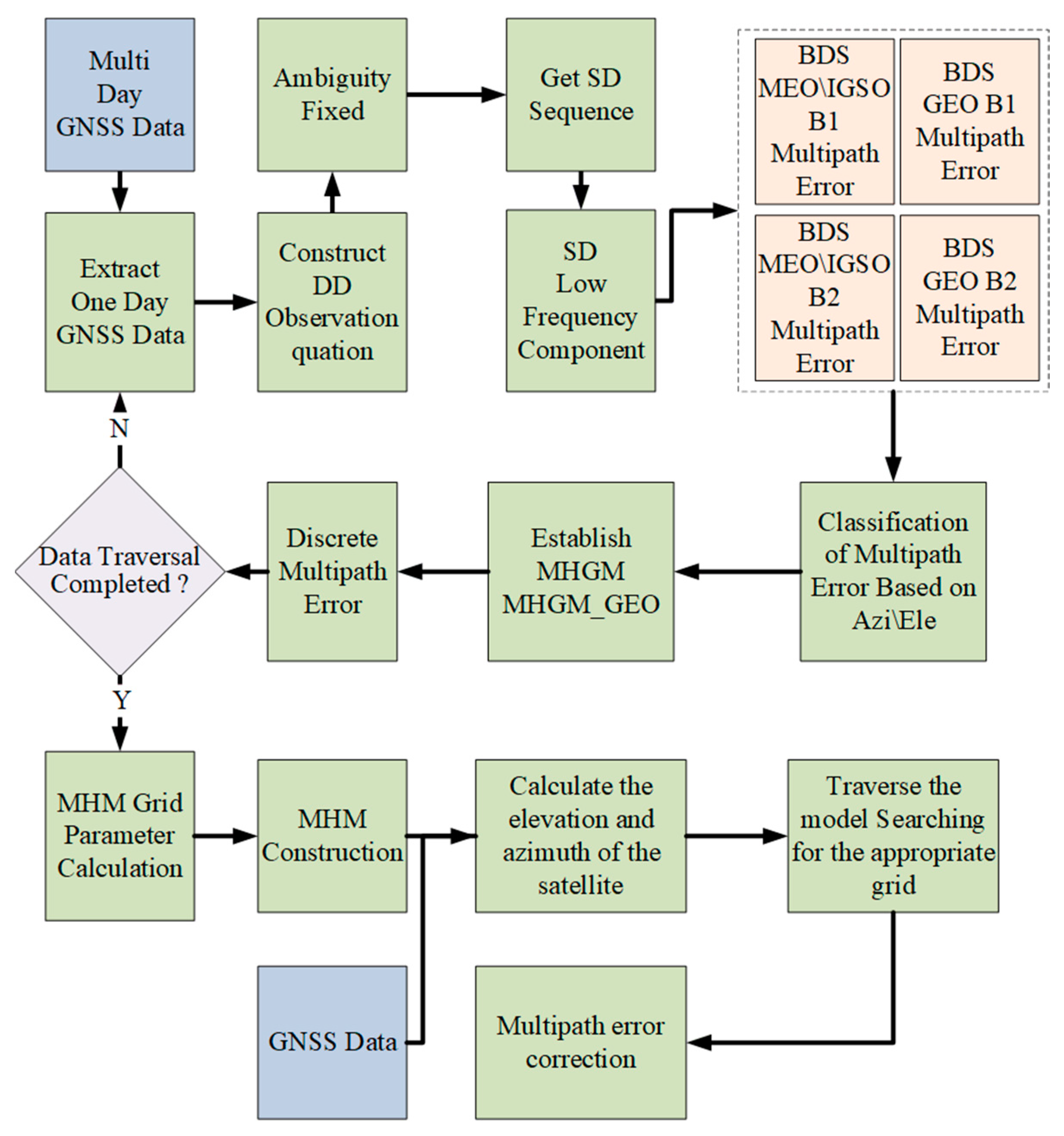




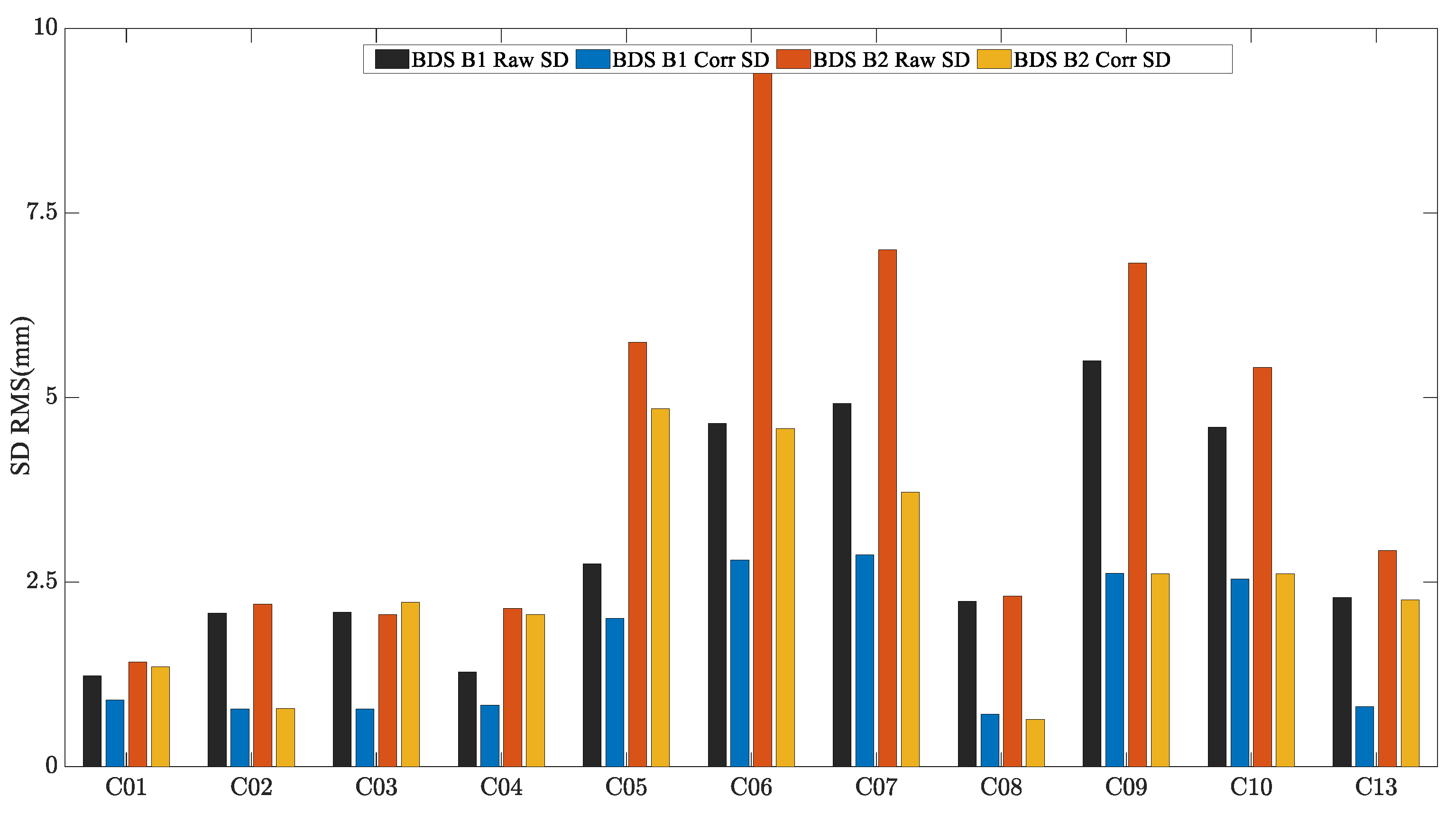


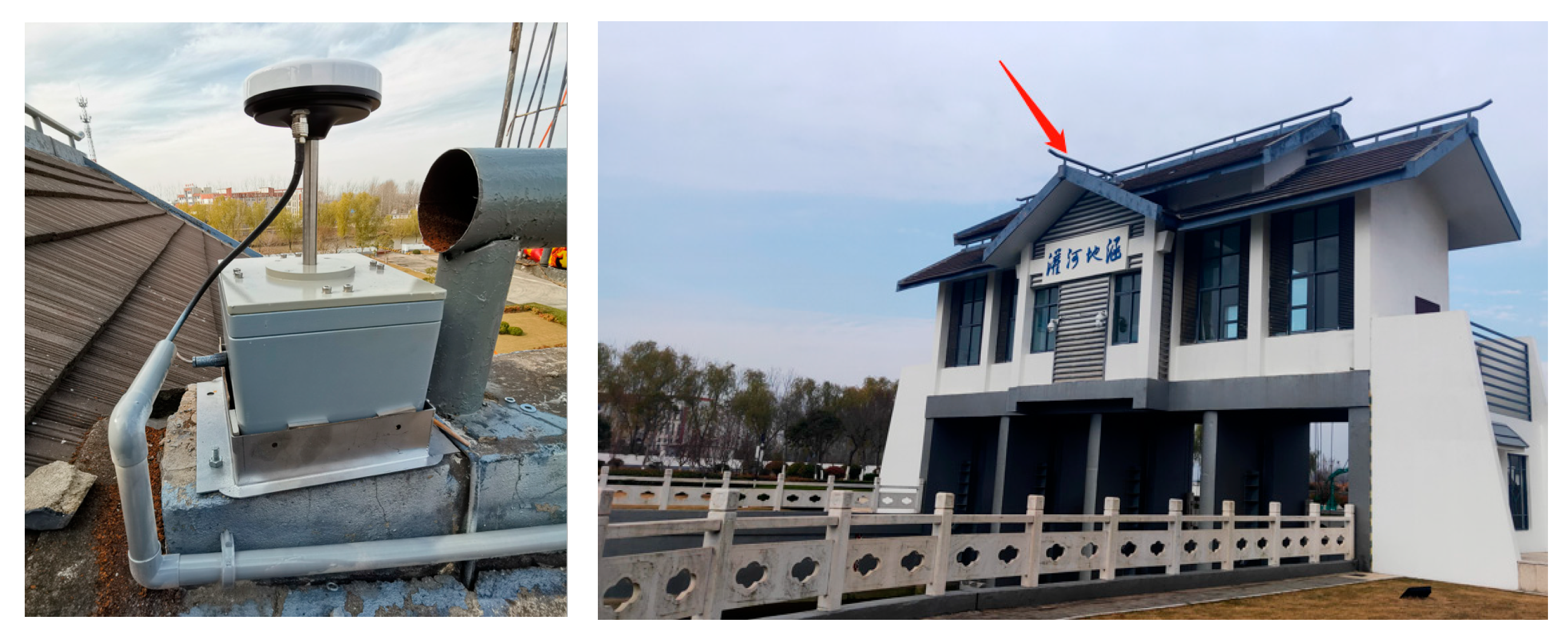
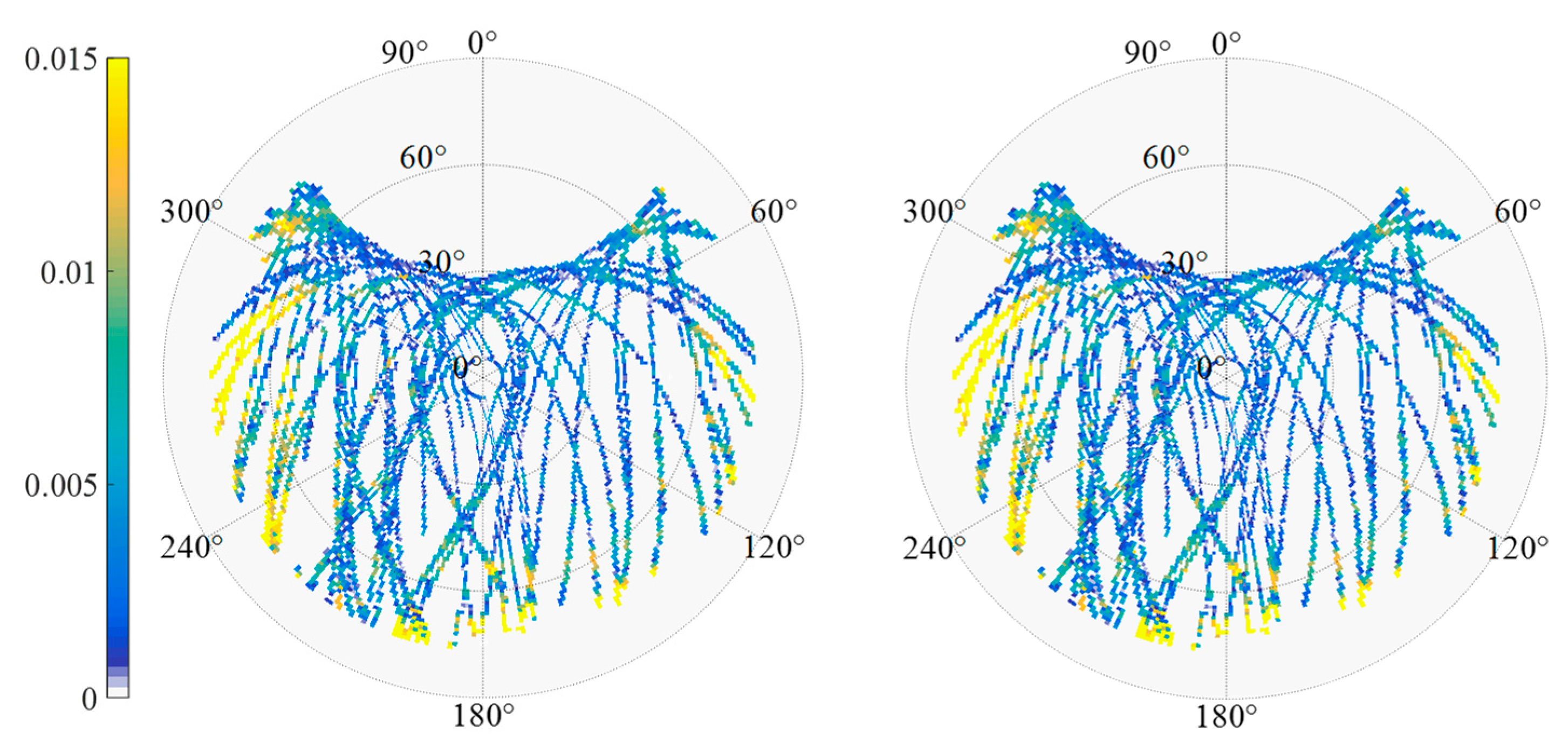
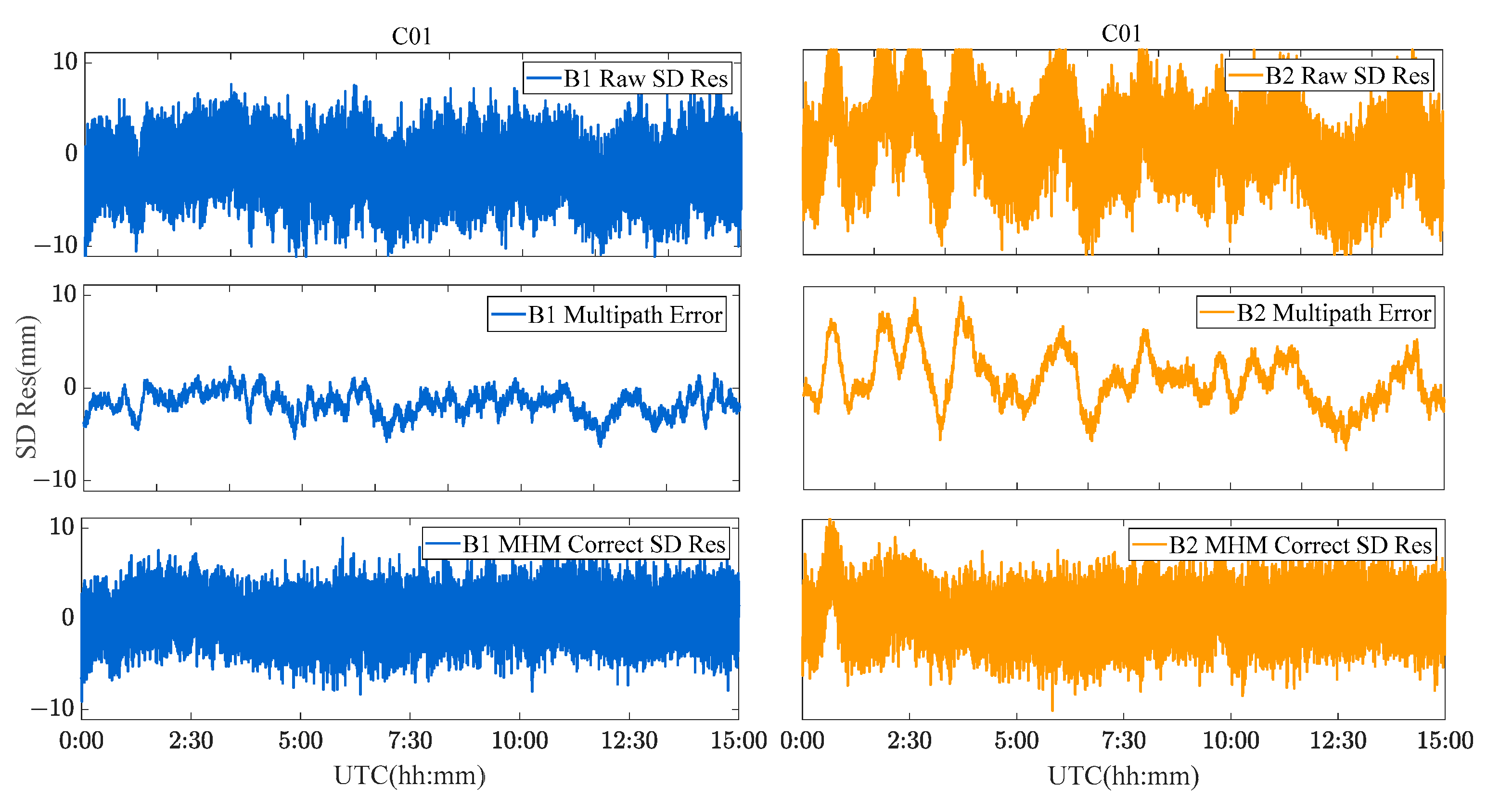
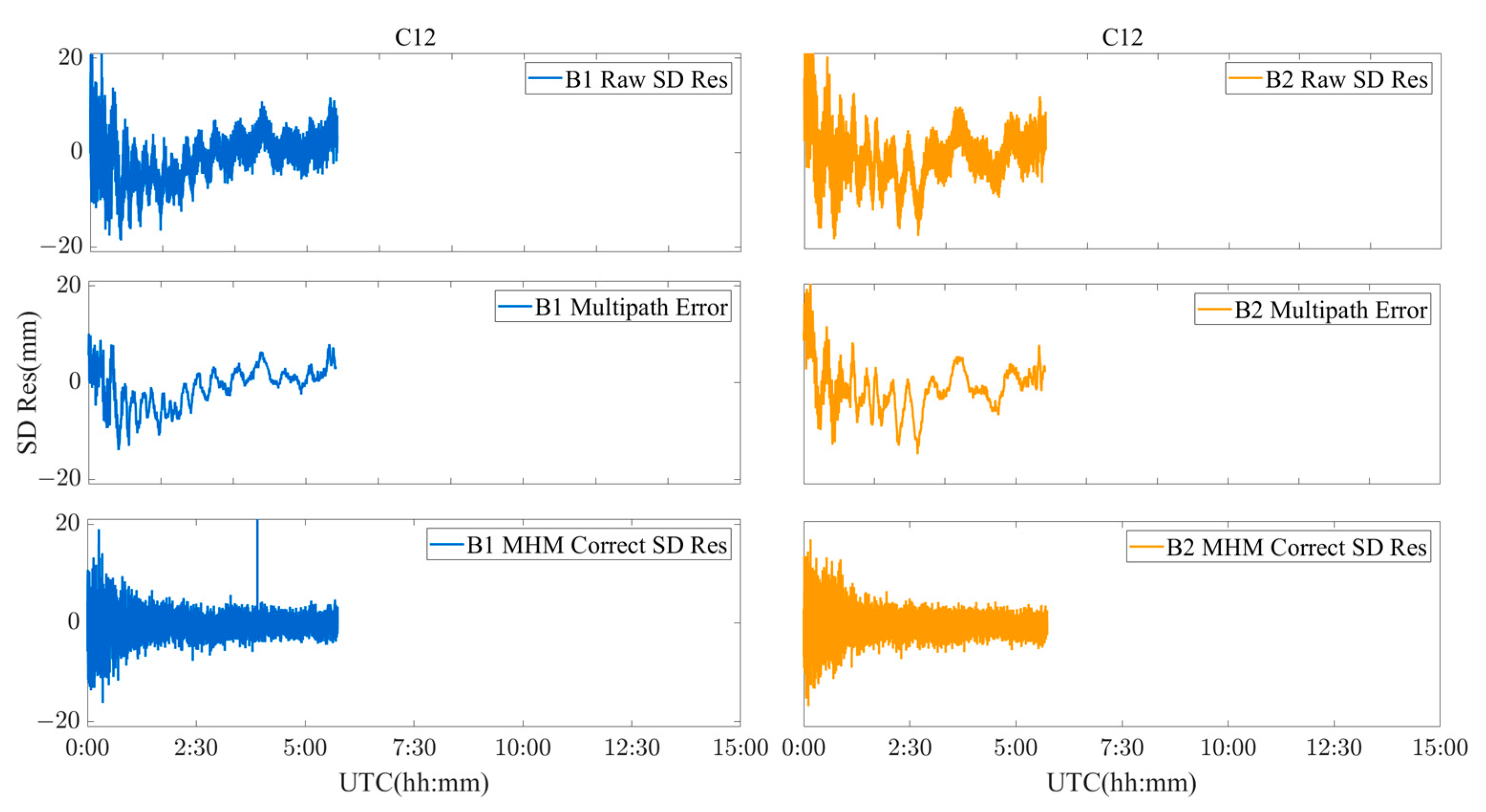

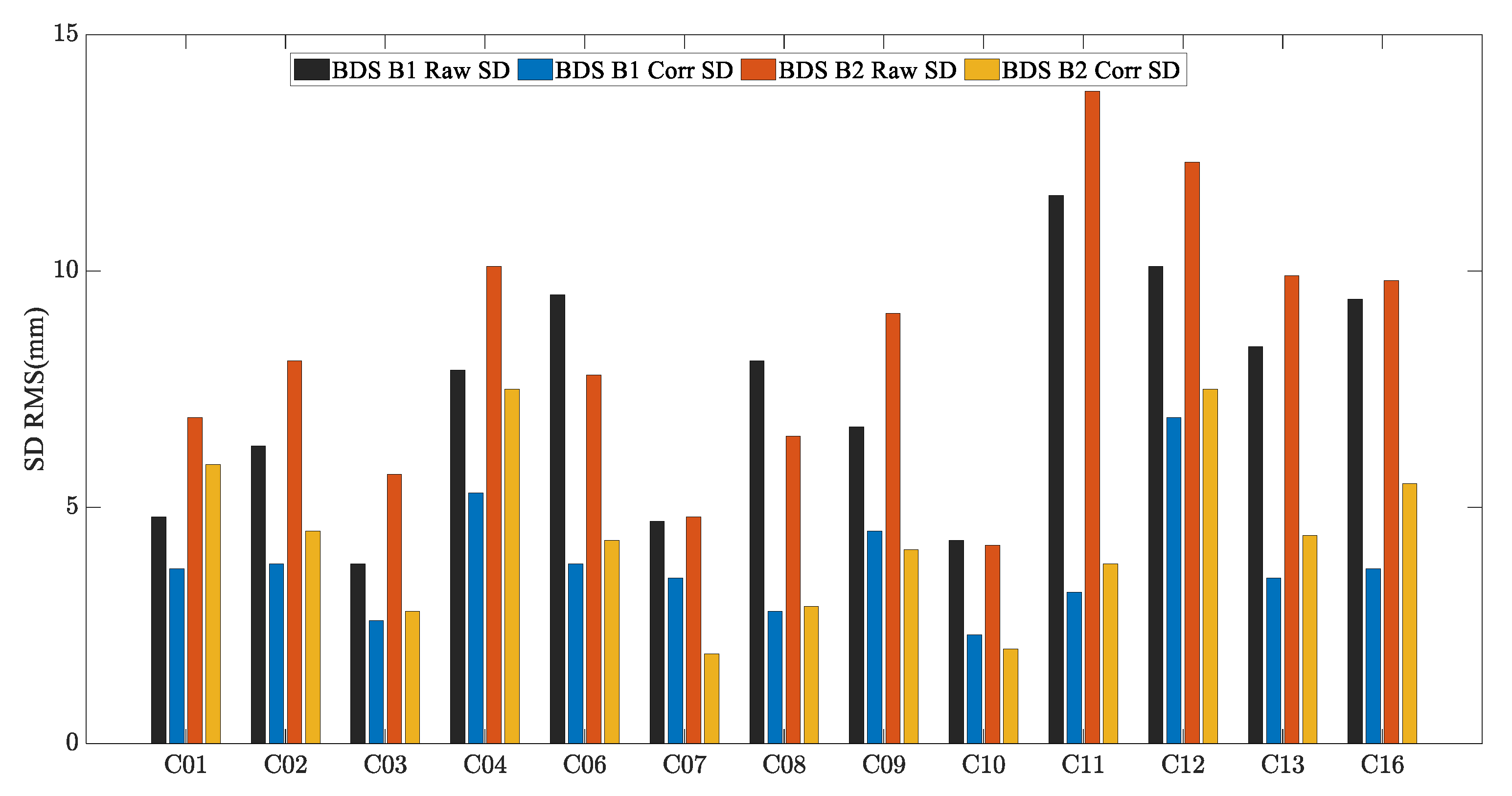
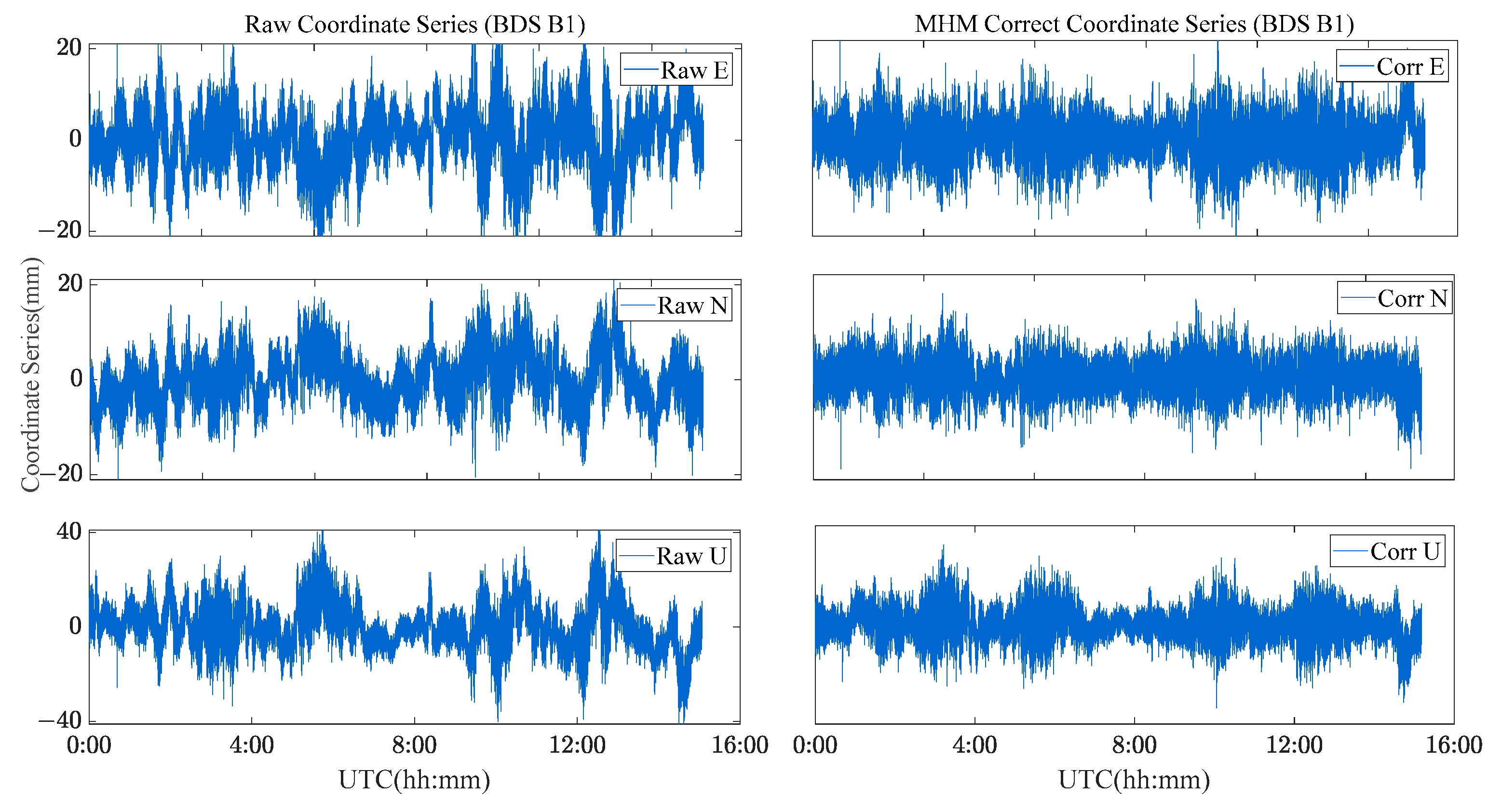

| Satellite System | Satellite Orbit | ||
|---|---|---|---|
| BDS | GEO | 0.05° | 0.05° |
| IGSO | 1° | 1° | |
| MEO | 1° | 1° |
| Solution | Satellite System | Frequency | Multipath Model | Cycle Slip Detection Method |
|---|---|---|---|---|
| Scheme A | BDS | B1 | -- | Pseudo-range/carrier combination method |
| Scheme B | MHM | |||
| Scheme C | B1 + B2 | -- | TurboEdit | |
| Scheme D | MHM |
| Control Group | Scheme | RMS/mm | Fixed Rate | ||
|---|---|---|---|---|---|
| E Direction | N Direction | U Direction | |||
| Single Frequency | A | 2.6 | 4.2 | 8.9 | 94.0% |
| B | 0.8 (69.2% ↑) | 1.0 (76.2% ↑) | 2.8 (68.5% ↑) | 99.9% | |
| Dual Frequency | C | 1.2 | 2.1 | 5.1 | 100% |
| D | 0.7 (41.7% ↑) | 0.9 (57.1% ↑) | 2.4 (52.3% ↑) | 100% | |
| Control Group | Scheme | RMS/mm | Fixed Rate | ||
|---|---|---|---|---|---|
| E Direction | N Direction | U Direction | |||
| Single Frequency | A | 8.2 | 9.0 | 23.9 | 92.2% |
| B | 1.4 (82.9% ↑) | 1.6 (82.2% ↑) | 3.6 (84.9% ↑) | 99.6% | |
| Dual Frequency | C | 2.8 | 3.5 | 10.4 | 99.6% |
| D | 1.4 (50.0% ↑) | 1.5 (57.1% ↑) | 3.7 (64.4% ↑) | 99.8% | |
Disclaimer/Publisher’s Note: The statements, opinions and data contained in all publications are solely those of the individual author(s) and contributor(s) and not of MDPI and/or the editor(s). MDPI and/or the editor(s) disclaim responsibility for any injury to people or property resulting from any ideas, methods, instructions or products referred to in the content. |
© 2023 by the authors. Licensee MDPI, Basel, Switzerland. This article is an open access article distributed under the terms and conditions of the Creative Commons Attribution (CC BY) license (https://creativecommons.org/licenses/by/4.0/).
Share and Cite
Sun, A.; Zhang, Q.; Gao, X.; Meng, X.; Zhang, Y.; Hancock, C. BDS Dual-Frequency Carrier Phase Multipath Hemispherical Map Model and Its Application in Real-Time Deformation Monitoring. Sensors 2023, 23, 6357. https://doi.org/10.3390/s23146357
Sun A, Zhang Q, Gao X, Meng X, Zhang Y, Hancock C. BDS Dual-Frequency Carrier Phase Multipath Hemispherical Map Model and Its Application in Real-Time Deformation Monitoring. Sensors. 2023; 23(14):6357. https://doi.org/10.3390/s23146357
Chicago/Turabian StyleSun, Ao, Qiuzhao Zhang, Xingwang Gao, Xiaolin Meng, Yunlong Zhang, and Craig Hancock. 2023. "BDS Dual-Frequency Carrier Phase Multipath Hemispherical Map Model and Its Application in Real-Time Deformation Monitoring" Sensors 23, no. 14: 6357. https://doi.org/10.3390/s23146357
APA StyleSun, A., Zhang, Q., Gao, X., Meng, X., Zhang, Y., & Hancock, C. (2023). BDS Dual-Frequency Carrier Phase Multipath Hemispherical Map Model and Its Application in Real-Time Deformation Monitoring. Sensors, 23(14), 6357. https://doi.org/10.3390/s23146357









